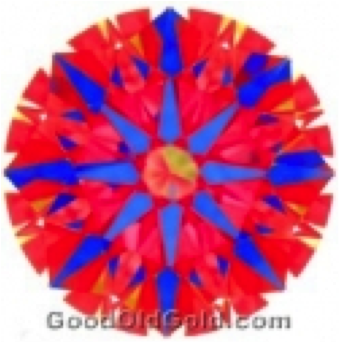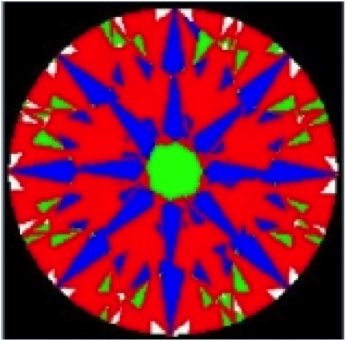I didn’t have to look hard to find this week’s question. There was a single stand out thread started by Jon a.k.a. ‘Rhino’ over at Good Old Gold with a simple challenge; to see if we could identify whether a diamond would be graded ideal/excellent by AGS, GIA, both, or neither.
You can read the thread for yourself here.
Now I will admit that before the answer was revealed, all I knew was that I was leaning toward the answer “Not enough information to make judgment”. I didn’t know for sure whether the diamond would not be GIAex or AGS0.
Let me tell you why.
This is the information we received from Rhino.
The specs of the diamond were:
| Weight | 1.21ct |
| Diameter | 6.89mm |
| Table | 57% |
| Depth | 60.70% |
| Crown Angle | 34.03 |
| Crown Height | 14.50% |
| Pavilion Angle | 40.66 |
| Girdle | 3.30% |
| Culet | Pointed |
We don’t have any information about the star facets, the lower girdles, or the upper girdles or an idealscope image. What we do have are the HCA results (which I knew were there to demonstrate the inadequacy of the HCA) so I quickly disregarded it.
Now we learnt from a previous PS Rockytalky Review that the GIA uses weight ratio as part of their Facetware software. It turns out that AGS also uses this as part of the AGS PGS software. AGS states that a diamond will receive a deduction if its weight exceeds a standard by more than 5%. This is generally stricter than GIA, which as we calculated last time was around 8%.
The weight ratio was actually not a red flag to me because the girdle thickness was only 3.3%, but I calculated the weight ratio of this diamond anyway. It turns out that the weight ratio is 1.03 (3%), which is well within what is acceptable.
More importantly we have two ASET images.
 |
 |
First we have a rather low quality image of an ASET taken of the actual diamond. I could not tell much from this image apart from being able to have a decent guess that the lower girdles were around 80%. There still doesn’t seem to be any red flags.
Next we have a computer-generated ASET from the AGS Performance Grading Software (AGS PGS). The software uses a sophisticated software engine to conduct a ray-tracing analysis on the scanned proportions of the actual diamond. This is the system that AGS utilises as part of their diamond grading methodology. Ray tracing analyses the physical symmetry of the diamond and any discrepancies in physical symmetry will manifest itself in optical symmetry as well. AGS acknowledges that this software takes into account facet pitch, yaw, and twist.
The ASET is effective for ruling out any significant painting or digging in this diamond. You can also see that there are hotspots around the table reflection, which are much more apparent in the computer-generated ASET. My impression was that the star length is definitely 55% or over.
Having analysed almost every aspect of this diamond, I still could not make a decision. Part of me leaning toward this diamond missing the mark in both labs, but this was influenced by partly knowing there must be a trick here. In the end, I settled for not having enough information, due to not knowing the exact star length.
It turned out that the star length was in fact the answer why this diamond misses the excellent mark in GIA. Rhino revealed that the average star length was 59.2%, which rounding to the nearest 5% puts it firmly at 60% and that makes this diamond a very good cut according to the GIA. Mind you, I have heard Rhino stating that the fact a diamond gets an automatic downgrade with 60% stars is an absurdity and I am in total agreement. Nevertheless, this didn’t surprise me because it was the AGS grade that I had less of a clue about. At this point, what I thought was that the downgrade must be because the diamond had a poor contrast pattern when it was being tilted. After all, AGS takes a 14-degree tilt (split into 5 positions) into account in their grading that we can’t see.
In the end, Rhino explained that the reason this diamond misses the AGS0 grade is because of its deduction in its contrast score. Now let me explain.
The ASET that is commonly used in images uses 30 degrees of obstruction. If you need a brush up on ASET you can have the ASET tutorial open, here is the link. This kind of ASET is known as ASET 30 and is similar to what we see in our hand-held version. But there is another kind of ASET, and that is ASET 40, which uses 40 degrees of obstruction. The AGS PGS uses both ASET 30 and ASET 40, which in combination with the way it uses tilt, means that AGS assesses the contrast pattern in 10 different views of the diamond. Rhino says that it is in the ASET 40 that the diamond receives its deduction but there isn’t an image available to see the effects.
Now with the AGS system, where contrast is the problem, there is always insufficient information. This is because AGS takes into account of many factors that affect the contrast pattern of the diamond and how it handles incident light. For example, there are corrections for the size of the diamond, for the binocular vision of humans, and also the already mentioned 30 and 40-degree obstruction.
The reason for having two standards for obscuration is to account for different people with different focal lengths. The closer you get to the diamond to view it, the greater the range of angles that your head is likely to be obstructing. This means that the viewing distance is very important. AGS uses 25cm as its standard for assessment. The takeaway today is that AGS and GIA have different ways to account for a poor appearance of a diamond when looking close at the diamond.
GIA has arguably a more basic and arguably conservative system because it first rejects by proportions and then visually checks those that pass to see if they need to be rejected. The problem with this system is that stones like this one, which may be perfectly good looking at certain viewing distances will be downgraded before it had a chance.
AGS has a more advanced system. Whether it is overly strict depends on whoever is purchasing that diamond. If the ASET 30 represents your focal length better than the ASET 40 when viewing the diamond from a 25cm distance, then a stone that misses the ideal cut grade will likely look no less beautiful than an AGS0.
Are either of the labs correct? This diamond was cut with 59.2% stars for the purpose of saving weight with the consequence of steeper upper girdles. It is 1.21ct, which puts it at the border of an important sub-price range. The lower girdles were cut long and shallow to compensate and the optics of this diamond is balanced. Rhino has told us that this diamond’s fate is to be re-cut.
But by re-cutting the stars, unless the lower girdles are cut steeper to compensate, the balance will be lost. If it is to be re-cut to maintain a correct balance in the diamond, then I am almost certain that the diamond will not be able to keep above the 1.2ct mark. On top of this there are always risks of re-cutting a diamond. Many in this thread have pointed out the shame that the failure of the grading systems combined with the economic pressures on the original diamond cutter has lead this perfectly good and well-loved diamond to have to be re-cut.